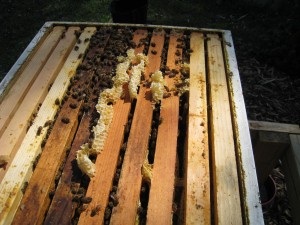Spotty Brood and Lots of Grumpiness
Yesterday, I attacked the ‘weak’ hive (I think I will start calling it the Albo Hive, after my brother=) to clean up the mess that I allowed to invade the hive last year. Upon opening up the hive, I was surprised to see that these bees were actually eating the pollen substitute. The Geronimo Bees (Hive 1) had given up eating on that stuff and I assumed that it was due to good pollen available in the wilds. Who knows. These gals are eating on it at a decent pace, so I left it on the hive.
I lit the smoker and suited up, as I figured things might get nasty when I delved into the lower brood chamber. But, I did not smoke them upon the breakdown of the upper Deep and all seemed ok. They only had a couple of frames of honey, but I believe this will be enough at this point (we are expecting 80’s for the next week or so). The weather could be a real boon for beekeeping in Richmond, Virginia. We’ve had a lot of rain and now we seem to be getting some good, warm temperatures.
Another thing to remember on the upper deep for the Albo Hive is that one of the frames is starting to come apart from the top bar on one side. This is one of the frames that is full of honey (so it is heavy) and probably is an accident waiting to happen. My goal will be to remove this frame and hopefully repair it once we get into mid-April or so (when I do not think they will need the honey.)
There was a lot of burr comb between the upper and lower Deep’s. I am not sure why this was the case, as they have plenty of room in the upper deep to build out more comb. Regardless, I turned on the smoker and began to remove all of this. Things got a little hairy during this episode, as every frame on the lower deep was covered with bees and the smoker only sent them scurrying for a second or two. But, I was able to get the burr comb off and begin removing and inspecting each frame.
During this adventure, the bees really got grumpy. I tried to remain calm and am sure that, without my gear, I would have gotten stung multiple times. On two or three occasions, I had to walk away from the hive and let them settle down a bit (once they get mad, smoke is only partially effective for these bees.) I had to remove a lot of propolis – a ton of it. I will be aware of this going forward. This stuff should be cleaned off each time you remove a frame.
Two other items of note (of great importance, actually) were the brood and a possible queen cell. Having just looked at (I am guessing) 7 or 8 frames full of brood in the Geronimo Hive last week, the spotty nature of this brood was definitely noticeable. The Geronimo hive had several frames that were literally full of capped brood – not one single miss. But, the Albo hive didn’t have a single frame that was chock full. Plenty were 95% full, but there were always a dozen or so empty cells scattered around. It gives the appearance of my queen being on drugs and missing here and there as she walks about the comb in a random (stumbling) pattern. This only confirmed to me that this queen needs to go.
I did also find what appeared to be a supercedure cell. It may have been what was left of the supercedure cell from last Fall, but who knows. I am hoping that this was a sign that they are going to raise another queen. The cell was in the upper half of the frame, so I left it alone and went about my business. I am certain that these gals would have died this last Winter if I had not intervened with feeding in the Summer, Fall and Winter. I will not intervene this year, so they better start getting it right.
What really got the girls mad was when I had to cut off the top part of some capped honey on one-half of one side of a frame that had ended up too far from its neighbor last Summer. Instead of light buzzing, they amped up to a high tenor and really started cursing at me, buzzing in my face and trying to sting my netting. But, I was able to get the frame trimmed down a bit and the frames fit very nicely together once I was finished.
All in all, this was a success. I did not find the queen, but did find eggs and larvae. I also located where they were storing nectar and pollen, near the brood nest. They should get to a decent start and, if they get a good queen, have time to collect a nice harvest during the flow in May. I did find some drone brood, so things are getting close.

